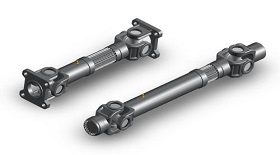Ball cage type universal joint
The structure of the ball cage type universal joint is that six steel balls are installed in the space opposite six sets of internal and external raceways and are confined to the same plane by cage 4. The power is driven by a linear motion bearing shaft 1 (and star sleeve), and passes through the steel ball 6 to the spherical shell 8 output. The inner spline of the star sleeve is connected with the driving shaft, and the outer surface of the star sleeve is provided with arc grooves of six linear bearing strips, forming an inner raceway. The inner surface of the spherical shell 8 has six arc grooves corresponding to the outer raceway. The basic principle of special bearing ensures that the force point of universal joint is always on the plane at the intersection of two shafts in the working process.
Advantages: the maximum angle of two axes is 42&am. When working, no matter what the transmission direction is, the six steel balls all transmit force. Compared with the ball fork type universal joint, the structure is compact, the bearing capacity is strong, and the disassembly and assembly are convenient.
Ball fork universal joint
If the inner and outer raceways are cylindrical, the sliding resistance is small, and the sliding splines in the deactivating device of the rotary table bearings are saved, the retractable ball cage type universal joint will be changed, which is suitable for the disconnected driving axle. At present, the constant-speed universal joint commonly used in car bearings is ball-cage type universal joint, and there are also spherical fork type universal joint or free three-pivot universal joint.



